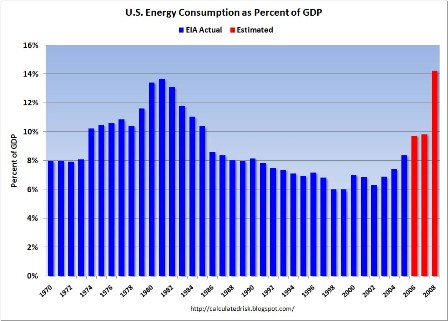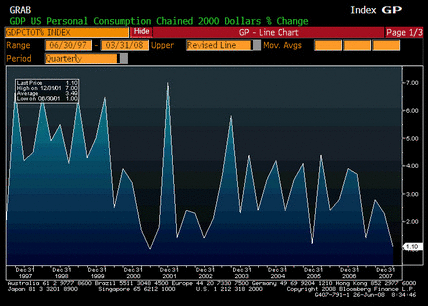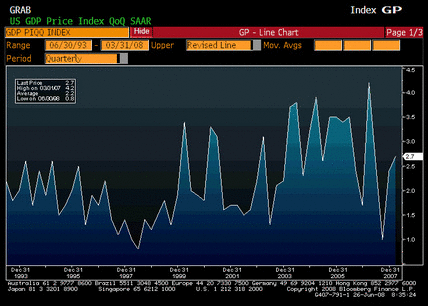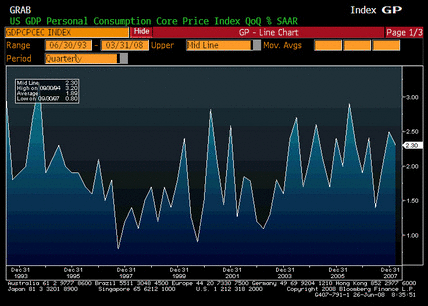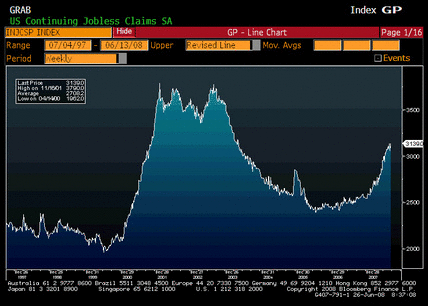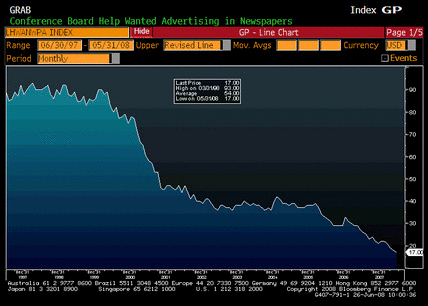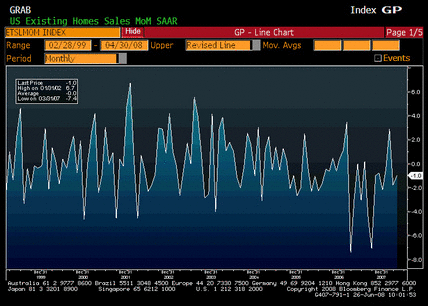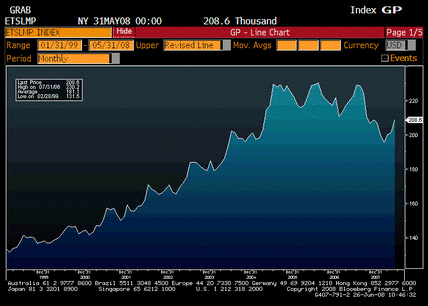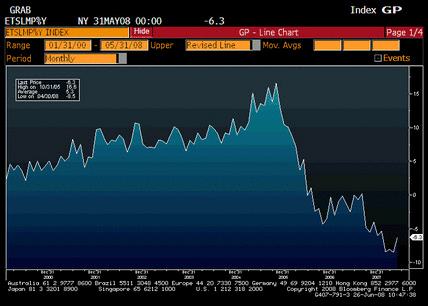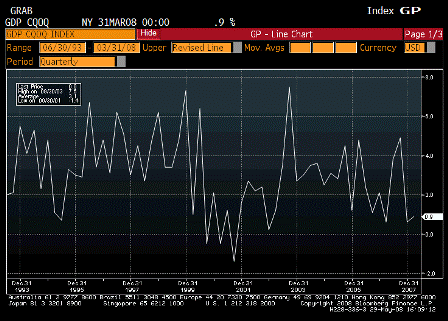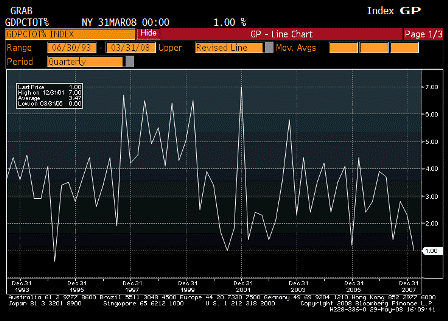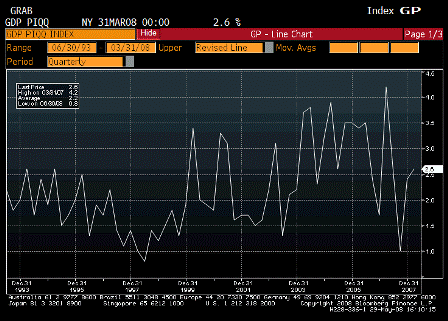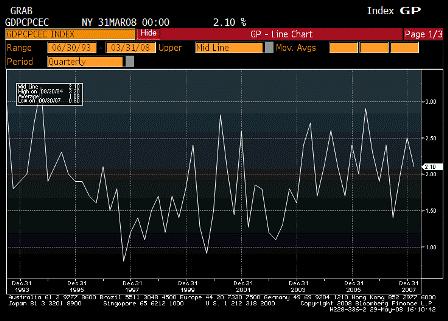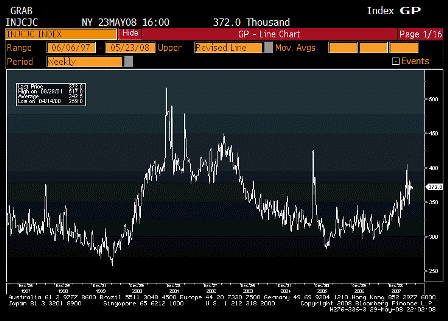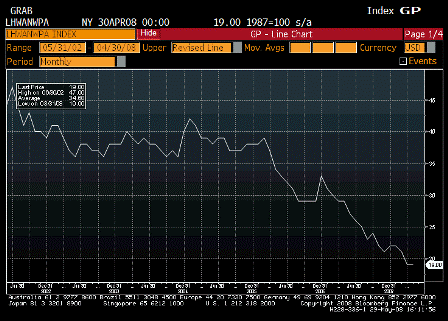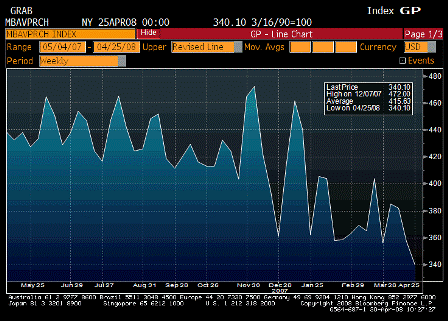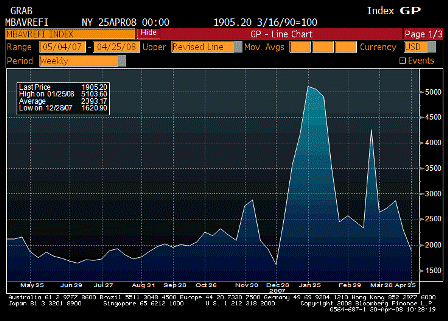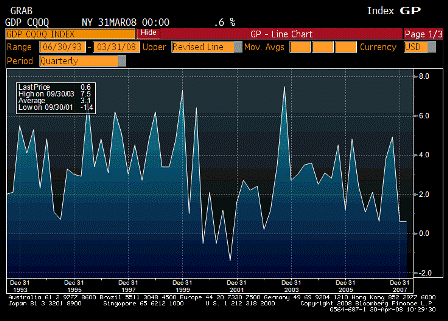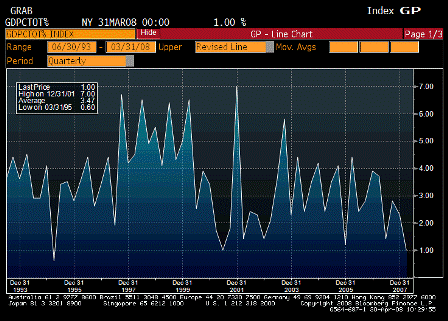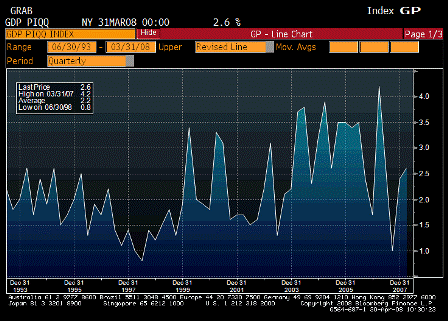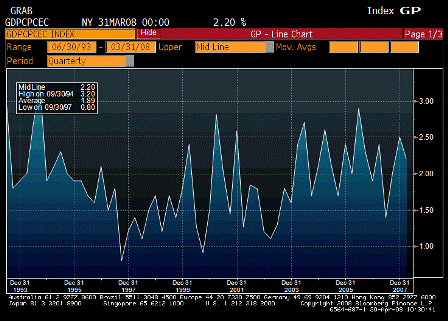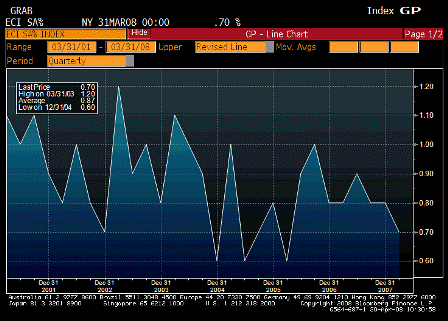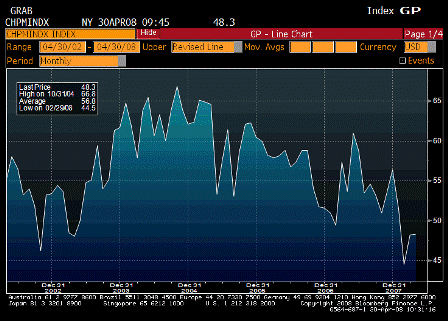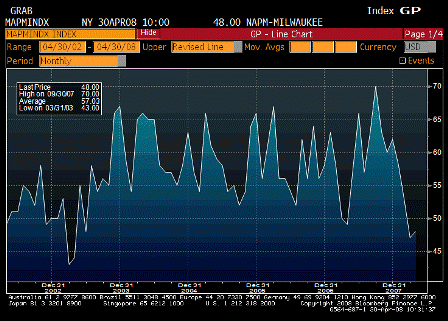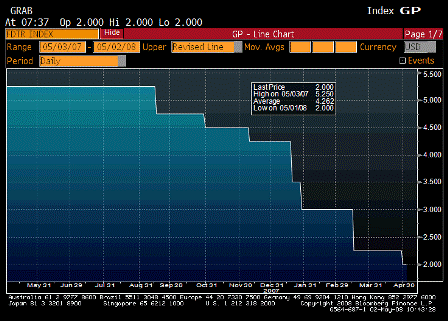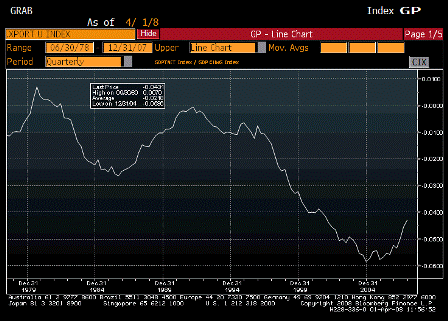[Skip to the end]
U.S. First Quarter Advance GDP: Statistical Summary (Table)
by Kristy Scheuble
(Bloomberg) Following is a summary of Gross Domestic Product from the Commerce Department.
| |
1Q |
4Q |
3Q |
2Q |
1Q |
4Q |
3Q |
| |
2008 |
2007 |
2007 |
2007 |
2007 |
2006 |
2006 |
Annualized Quarterly Change
| Real GDP |
0.6% |
0.6% |
4.9% |
3.8% |
0.6% |
2.1% |
1.1% |
| YOY percent |
2.5% |
2.5% |
2.8% |
1.9% |
1.5% |
2.6% |
2.4% |
Year over year looks fine.
| Personal consumption |
1.0% |
2.3% |
2.8% |
1.4% |
3.7% |
3.9% |
2.8% |
Down, but holding positive as income continues to grow.
| Durable goods |
-6.1% |
2.0% |
4.5% |
1.7% |
8.8% |
3.9% |
5.6% |
| Nondurable goods |
-1.3% |
1.2% |
2.2% |
-0.5% |
3.0% |
4.3% |
3.2% |
| Services |
3.4% |
2.8% |
2.8% |
2.3% |
3.1% |
3.7% |
2.0% |
Services picking up the slack from goods.
| Gross private investment |
-4.7% |
-14.6% |
5.0% |
4.6% |
-8.2% |
-14.1% |
-4.1% |
| Fixed investment |
-9.7% |
-4.0% |
-0.7% |
3.2% |
-4.4% |
-7.1% |
-4.7% |
| Nonresidential |
-2.5% |
6.0% |
9.3% |
11.0% |
2.1% |
-1.4% |
5.1% |
| Structures |
-6.2% |
12.4% |
16.4% |
26.2% |
6.4% |
7.4% |
10.8% |
| Equipment & software |
-0.7% |
3.1% |
6.2% |
4.7% |
0.3% |
-4.9% |
2.9% |
| Residential |
-26.7% |
-25.2% |
-20.5% |
-11.8% |
-16.3% |
-17.2% |
-20.4% |
Housing still subtracting quite a bit, has to taper off as it bottoms albeit at very low levels.
| |
1Q |
4Q |
3Q |
2Q |
1Q |
4Q |
3Q |
| |
2008 |
2007 |
2007 |
2007 |
2007 |
2006 |
2006 |
| Exports |
5.5% |
6.5% |
19.1% |
7.5% |
1.1% |
14.3% |
5.7% |
| Goods |
5.2% |
3.9% |
26.2% |
6.6% |
0.9% |
9.6% |
7.4% |
| Services |
6.1% |
13.2% |
4.0% |
9.6% |
1.6% |
26.0% |
2.0% |
March trade report could revise exports much higher…
| Imports |
2.5% |
-1.4% |
4.4% |
-2.7% |
3.9% |
1.6% |
5.4% |
| Goods |
2.4% |
-2.6% |
4.8% |
-2.9% |
4.2% |
-0.6% |
6.2% |
| Services |
3.5% |
5.5% |
1.7% |
-1.7% |
2.3% |
14.2% |
1.3% |
and imports lower.
| Government consumption |
2.0% |
2.0% |
3.8% |
4.1% |
-0.5% |
3.5% |
0.8% |
| Federal |
4.6% |
0.5% |
7.1% |
6.0% |
-6.3% |
7.3% |
0.9% |
| National defense |
6.0% |
-0.5% |
10.1% |
8.5% |
-10.8% |
16.9% |
-1.5% |
| Nondefense |
1.8% |
2.8% |
1.1% |
0.9% |
3.8% |
-10.0% |
6.0% |
Federal government spending deferred from 2007 kicking in, especially defense..
| State and local |
0.5% |
2.8% |
1.9% |
3.0% |
3.0% |
1.3% |
0.7% |
As state and local growth slows.
Other Measures
| Change in inventories $B |
$1.8 |
-$18.3 |
$30.6 |
$5.8 |
$0.1 |
$17.4 |
$53.9 |
| Net exports $B |
-$496 |
-$503 |
-$533 |
-$574 |
-$612 |
-$597 |
-$634 |
| Real final sales |
-0.2% |
2.4% |
4.0% |
3.6% |
1.3% |
3.5% |
1.0% |
| Gross domestic purchases |
0.4% |
-0.4% |
3.3% |
2.4% |
1.1% |
0.8% |
1.3% |
| Final sales to dom purch |
-0.4% |
1.3% |
2.5% |
2.1% |
1.7% |
2.1% |
1.2% |
Contribution to Change in GDP
| Real GDP |
0.6% |
0.6% |
4.9% |
3.8% |
0.6% |
2.1% |
1.1% |
If revised up with March trade numbers, Q4 would have been the bottom.
| Personal consumption |
0.68% |
1.58% |
2.01% |
1.00% |
2.56% |
2.68% |
1.88% |
| Durables |
-0.48% |
0.15% |
0.35% |
0.14% |
0.67% |
0.30% |
0.43% |
| Motor Vehicle |
-0.37% |
0.09% |
-0.17% |
-0.10% |
0.35% |
0.00% |
0.16% |
| Nondurables |
-0.27% |
0.25% |
0.46% |
-0.10% |
0.61% |
0.86% |
0.64% |
| Services |
1.43% |
1.18% |
1.20% |
0.96% |
1.28% |
1.52% |
0.81% |
| Housing |
0.23% |
0.34% |
0.27% |
0.29% |
0.26% |
0.20% |
0.18% |
Again, services picking up the slack.
| Gross pvt dom invest |
-0.70% |
-2.40% |
0.77% |
0.71% |
-1.36% |
-2.50% |
-0.70% |
| Fixed investment |
-1.50% |
-0.62% |
-0.11% |
0.49% |
-0.70% |
-1.19% |
-0.80% |
| Nonresidential |
-0.28% |
0.63% |
0.96% |
1.12% |
0.22% |
-0.15% |
0.53% |
| Structures |
-0.23% |
0.41% |
0.52% |
0.78% |
0.20% |
0.23% |
0.31% |
| Equipment & software |
-0.05% |
0.22% |
0.44% |
0.34% |
0.02% |
-0.38% |
0.21% |
| Info processing |
0.23% |
0.51% |
0.24% |
0.36% |
0.56% |
-0.06% |
0.24% |
| Computers |
0.12% |
0.20% |
0.08% |
0.08% |
0.25% |
0.03% |
0.09% |
| Software |
0.13% |
0.18% |
0.07% |
0.16% |
0.14% |
0.04% |
0.05% |
| Residential |
-1.23% |
-1.25% |
-1.08% |
-0.62% |
-0.93% |
-1.04% |
-1.33% |
Soft quarter for investment at least partially due to the widespread recession psychology.
| |
1Q |
4Q |
3Q |
2Q |
1Q |
4Q |
3Q |
| |
2008 |
2007 |
2007 |
2007 |
2007 |
2006 |
2006 |
| Change in inventories |
0.81% |
-1.79% |
0.89% |
0.22% |
-0.65% |
-1.31% |
0.10% |
| Nonfarm |
0.93% |
-1.69% |
0.87% |
0.27% |
-0.69% |
-1.56% |
0.01% |
| Net exports |
0.22% |
1.02% |
1.38% |
1.32% |
-0.51% |
1.25% |
-0.25% |
| Exports |
0.67% |
0.77% |
2.10% |
0.85% |
0.13% |
1.51% |
0.62% |
| Goods |
0.45% |
0.33% |
1.96% |
0.53% |
0.07% |
0.73% |
0.56% |
| Services |
0.22% |
0.45% |
0.14% |
0.33% |
0.05% |
0.78% |
0.07% |
| Imports |
-0.44% |
0.24% |
-0.72% |
0.47% |
-0.63% |
-0.26% |
-0.88% |
| Goods |
-0.35% |
0.39% |
-0.67% |
0.42% |
-0.57% |
0.09% |
-0.84% |
| Services |
-0.09% |
-0.15% |
-0.05% |
0.05% |
-0.06% |
-0.35% |
-0.03% |
| Govt. consumption |
0.39% |
0.38% |
0.74% |
0.79% |
-0.09% |
0.66% |
0.14% |
| Federal |
0.32% |
0.04% |
0.50% |
0.41% |
-0.46% |
0.50% |
0.06% |
| National defense |
0.28% |
-0.03% |
0.47% |
0.39% |
-0.54% |
0.74% |
-0.07% |
| Nondefense |
0.04% |
0.06% |
0.03% |
0.02% |
0.08% |
-0.24% |
0.14% |
| State and local |
0.07% |
0.34% |
0.24% |
0.37% |
0.36% |
0.16% |
0.08% |
Implicit Price Deflators
| GDP |
2.6% |
2.4% |
1.0% |
2.6% |
4.2% |
1.7% |
2.4% |
And higher numbers are in the pipeline as per the PPI and CPI reports.
| Gross domestic purchases |
3.5% |
3.7% |
1.7% |
3.8% |
3.8% |
0.1% |
2.5% |
Not bad.
| |
1Q |
4Q |
3Q |
2Q |
1Q |
4Q |
3Q |
| |
2008 |
2007 |
2007 |
2007 |
2007 |
2006 |
2006 |
Price Indexes
| GDP |
2.6% |
2.4% |
1.0% |
2.6% |
4.2% |
1.7% |
2.4% |
| YOY percent |
2.2% |
2.6% |
2.4% |
2.7% |
2.9% |
2.7% |
3.2% |
| Personal consumption |
3.5% |
3.9% |
1.8% |
4.3% |
3.5% |
-0.9% |
2.6% |
| YOY percent |
3.4% |
3.4% |
2.1% |
2.3% |
2.3% |
1.9% |
2.9% |
Moving up.
| ex food and energy |
2.2% |
2.5% |
2.0% |
1.4% |
2.4% |
1.9% |
2.3% |
| Real final sales |
2.7% |
2.4% |
1.0% |
2.7% |
4.2% |
1.7% |
2.3% |
Moving up.
| Gross domestic purchases |
3.5% |
3.7% |
1.8% |
3.8% |
3.8% |
0.1% |
2.5% |
Unannualized Quarterly Change
| Current GDP |
0.8% |
0.7% |
1.5% |
1.6% |
1.2% |
0.9% |
0.9% |
| Real GDP |
0.1% |
0.1% |
1.2% |
0.9% |
0.2% |
0.5% |
0.3% |
Seen a lot worse..
Weakness but no recession and even some improvement on the horizon as government and exports pick up the slack from housing and the financial sector.
Employment softer but still reasonably firm by mainstream standards with unemployment at 5%.
Prices continue firm as Saudis continue to hike crude prices, even as other commodities settle down some.
Hence, I see a narrowing output gap and higher prices on the horizon, and Fed rate hikes at least as aggressive as currently priced by the FF futures market.
[top]
